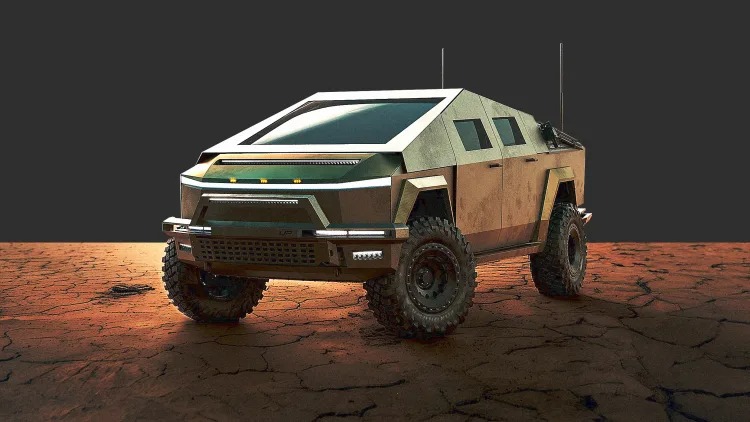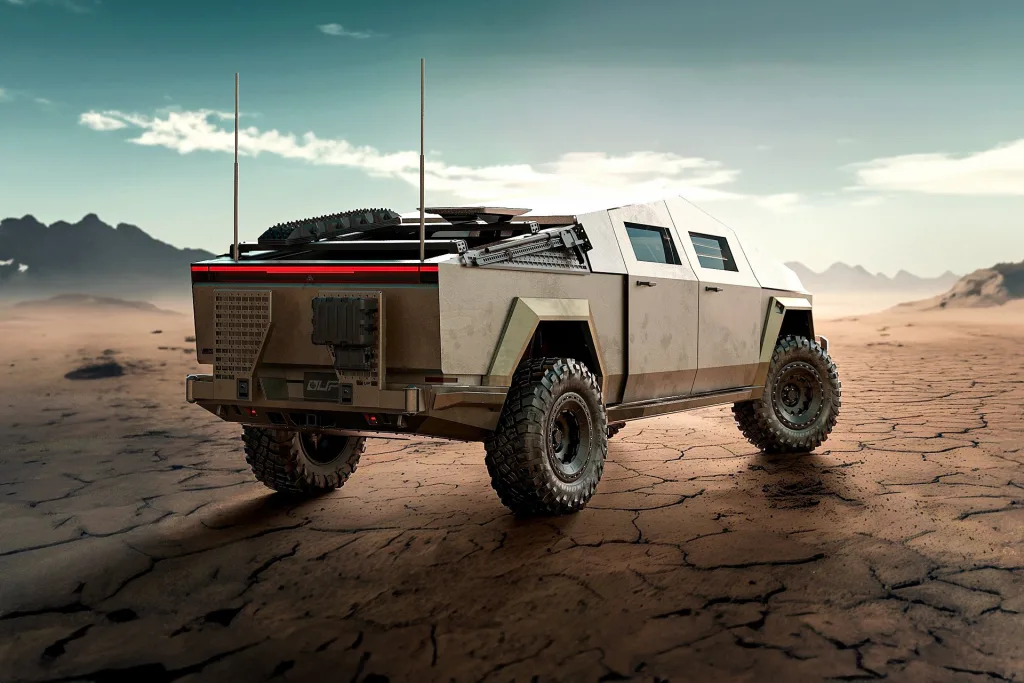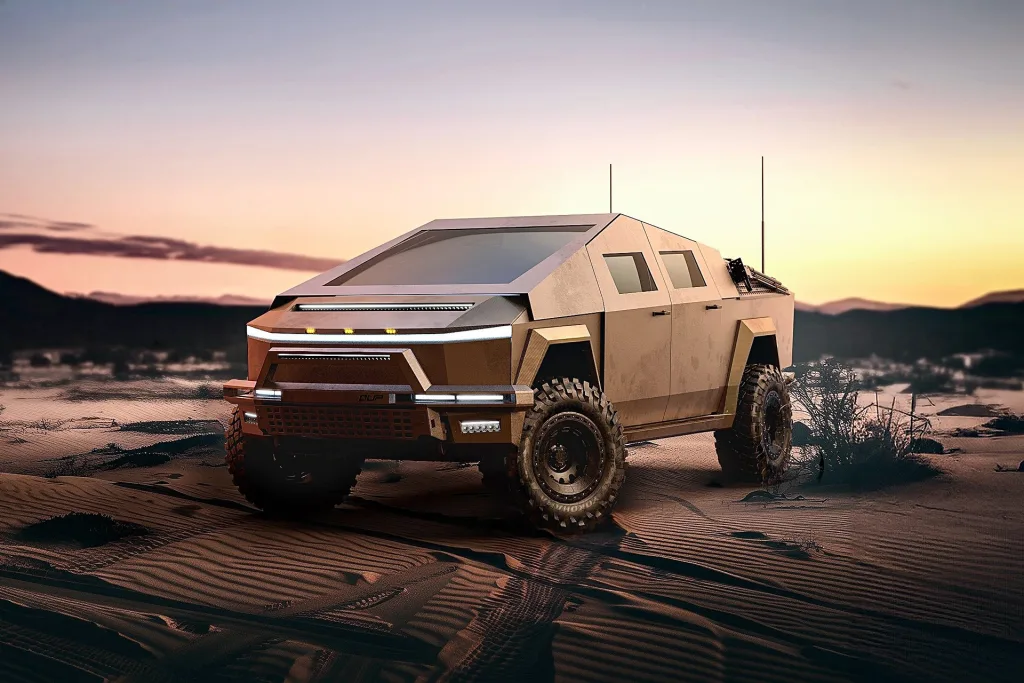- | 8:00 am
Finally, the Cybertruck can reach its true dystopian potential
Elon Musk’s post-apocalyptic vision for the Cybertruck was never technically possible until these wild upgrades came along.

While billed as a post-apocalyptic super truck, in reality, the Cybertruck is actually a mess of manufacturing problems that wouldn’t survive a day in truly dire circumstances. But fear not, my dear survivalists and Tesla bros, because there’s nothing that money can’t fix. Case in point: the Cybertruck Sting, an upgrade package that will turn Elon Musk’s truck into a vehicle that can save your life in case you have to drive through a desert full of mines while zombies fire heavy machine guns at you.
Musk’s pickup is known to have a rather dubious integrity track record. It sports a corrosion- and rust-prone steel body, and it won’t resist a steel ball thrown by a human hand. But it will chop off the latter if you are not careful. While many of these problems come from questionable design decisions and poor quality, perhaps one of the Cybertruck’s main problems is that it is neither here nor there when it comes to claiming any dystopia-proof badge.
It’s now clear that Tesla didn’t really set out to make a disaster-proof vehicle, just one that looked like it. For starters, its design couldn’t be too heavy due to regulatory laws that limit its weight, especially in Europe. If Tesla wants to sell it to as many people as possible, the car needs to be under a certain weight that would allow anyone with a regular car license to drive it in any state and in Europe. As a result, it simply can’t be as indestructible as Musk promised.

That’s where the upgrade comes in. Unplugged Performance (UP), a company that specializes in upgrading the Cybertruck for police and military forces, partnered with Archimedes Defense, which produces high-power electrical engines for defense applications, on the Sting. Together, they created a series of upgrade packages designed to transform the Cybertruck into a more robust and functional vehicle for both off-grid and high-threat environments.
There are three packages now available sans price tag (but for $500, you can reserve one). The entry point is the Sting Baja, which equips the Cybertruck with a set of features aimed at maximizing off-grid functionality. It will get you a compact, lightweight, aviation-derived 800V electric generator in the vehicle’s front trunk, er, frunk. This frunk generator, says UP, can run on multiple types of fuel: aviation Jet A and JP-8, diesel, and biodiesel. The generator operates as a direct-drive piston system without a gearbox, increasing its efficiency and reliability in rugged conditions, the company claims.
This generator is capable of supercharging the Cybertruck at up to 125kW, ensuring that the vehicle can maintain power in remote locations where traditional charging infrastructure is unavailable, which makes it okay to go out camping on a remote beach for a couple days. It also comes with a charging cable that allows the Cybertruck to rescue-charge other vehicles, with adaptors available for those that do not use the NACS standard. This capability extends the Cybertruck’s utility beyond its own operation, making it a potential lifeline for other electric vehicles in remote or disaster-stricken areas.
Then there’s the Sting Protector package, which gets a bit more serious by adding external armor to the Cybertruck. This package includes bolt-on/bolt-off external offset-steel-armor plating designed to withstand 7.62mm rounds. This level of armoring is intended for moderate-threat environments, making it suitable for private individuals, corporate entities, and government agencies operating in regions where there are moderate security risks.
Finally, the Sting APC package includes the features in the Protector package but adds IED (improvised explosive devices, like those used in war zones) and mine protection, along with upgraded armor capable of deflecting 14.5mm heavy machine-gun fire. The armor in this package includes both steel and ceramic components, offering a higher degree of resistance to extreme threats. The optional generator in the APC package further extends the vehicle’s operational range, making it suitable for long-duration missions in hostile or remote areas.

Fear-driven design
The Cybertruck Sting may turn Musk’s dystopian promise of a truck into reality. It’s only the latest chapter in the trend of militarizing trucks and SUVs so they become unwieldy monsters (see, for example, the Rezvani Vengeance). The Vengeance is a purpose-built vehicle designed from the ground up to offer protection and intimidation, which includes features such as bulletproof glass, underside explosive protection, biological warfare protection, and even electrified door handles. Starting at $250,000, it’s not for everyone. As Jordan Golson—the transportation reporter for the blog Inverse—tells me over email: “It’s a car for rich dudes. Really rich dudes, who collect cars.”
This modern monster-truck trend is driven by fear, which is in turn influenced by global events and a growing market demand for vehicles that offer more than just transportation. As Adrian Clarke—a professional car designer who now writes for the blog The Autopian—told me over email, people are increasingly looking for vehicles that make them feel safe and in control, especially in uncertain times. Golson thinks that the trend toward bigger, more intimidating models, is actually quite natural: “These may seem huge and intimidating for someone living in Brooklyn, but next to a semi on the interstate, they look pretty normal.”
He’s not wrong. Maybe that’s why, to me, the Sting flavors of the Cybertruck make a lot more sense than the original. These packages take the Cybertruck’s original idea and push it to its ultimate design consequences, as if they are saying to Musk: “If you are going to make a vehicle for real-world Mad Max, you better do it right.”





































